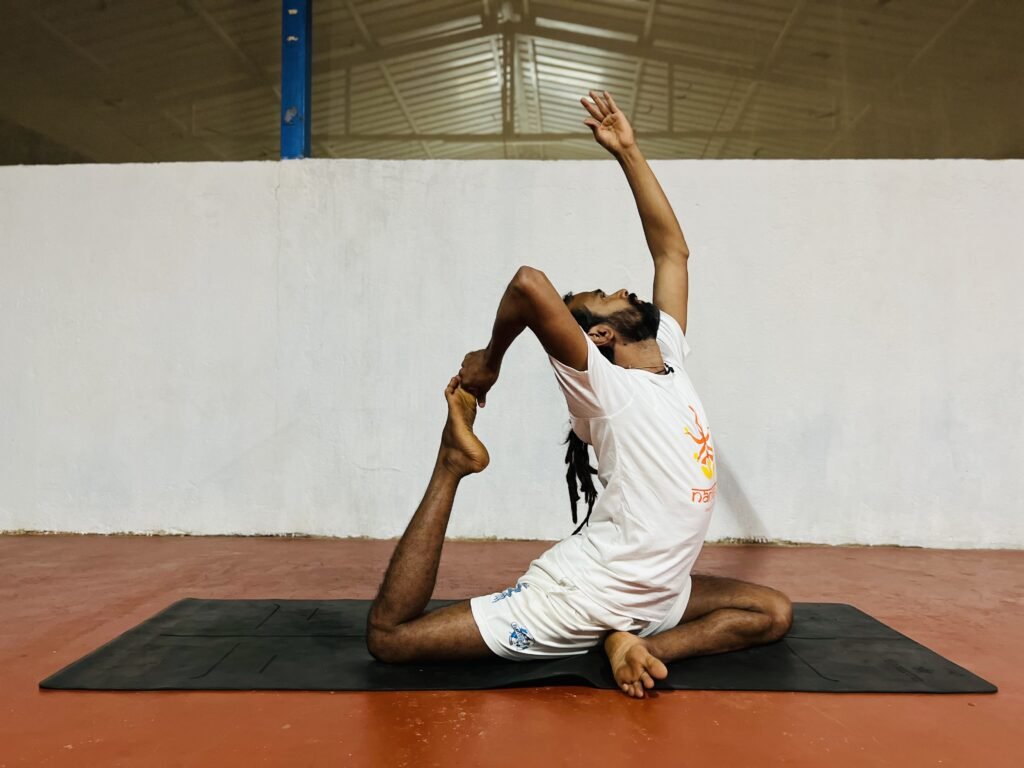
One of the most challenging yoga poses is the Eka Pada Rajakapotasana, popularly referred to as the King Pigeon Pose. This asana’s name is derived from the Sanskrit words “eka” for “one,””pada” for “foot,””raja” for “king,” and “kapota” for “pigeon” For many people, the one-legged king pigeon pose (Eka Pada Rajakapotasana) provides a much-needed deep hip opening.
Your body’s movement is centered on your hips. Opening this area will increase your range of motion, improve circulation to your lower extremities, and make you feel more at peace during meditation, seated poses, and daily life.
King Pigeon Pose will inevitably cause some emotions to surface because it opens both your hips and your heart. The pose will be much more satisfying if you have experience managing this vulnerability and emotional release. You will know when you are psychologically and physically prepared to do it; have faith in yourself.
This posture can be a powerful therapeutic technique and a terrific way to improve your flexibility, confidence, and sense of inner strength and self-love when used with humility and awareness.
It’s a strong stretch that necessitates careful alignment, so approach this position with awareness and consideration. Take your time, and focus on breathing.
Step-by-step directions for the One-Legged King Pigeon Pose
- Beginning on your hands and knees, slide your left knee forward and angle your left shin under your chest until your left foot is at the front of your right knee and your left shin is resting on the floor.
- Gently slide your right leg back, putting the top of your thigh on the floor while straightening your knee.
- Bring your left outside backside to the ground.
- Set your left heel directly in front of your right hip.
- Your left knee may slant slightly to the left, away from your hip’s line of symmetry. Backing up, notice your right leg. From your hip, it should extend straight back.
- Move your torso out from under your thigh. By pushing your tailbone downward and forward, lengthen your lower back.
- Point your right front hip slightly toward your left heel.
- After holding the position for a few breaths, release each hand one at a time, and descend your torso to the floor while maintaining a long spine.
- Remain briefly while placing your forehead or forearms on the ground. Return to your hands and knees after rising and taking a breath.
- Continue on the opposite side.
Benefits of Eka Pada Rajakapotasana
-
Anatomical benefits
- Muscles: While holding this position, the muscles at various levels of the body are toned- pelvic region, hamstrings, lower back, hips, thighs, psoas, abdomen, chest, shoulders, and calves. These muscles’ total toning contributes to the overall toning of the entire outer body.
-
Health Advantages
-
- Organs: The internal abdominal organs are stimulated when the abdominal muscles and psoas muscles are worked. The pancreas, liver, and kidney are all properly massaged, allowing for efficient secretion of the digestive juices for good digestion. This enhances the efficiency of these organs. Stretched and toned pelvic muscles make room for a better reproductive system.
The chest muscles expand, allowing the heart and lungs to work correctly.
The neck stretch creates space for the thyroid glands to function properly. As the muscles are stretched out in this stance, the internal organs are often toned.
- Symptoms: This position eases leg cramps, which helps the sciatic nerve, neck stiffness, and any lower back irritation. It also improves digestion, which helps migraine sufferers. It is possible to fix the sagging shoulders to provide the appearance of strength and firmness. Women’s menstrual cramps can be healed. Due to the stretching of the entire spine, any neurological imbalance is improved.
- Therapeutic applications: The thyroid is normalized, the uterus functions, the immune system, and back pain is relieved. Urinary problems are managed medically.
Eka Pada Rajakapotasana Contraindications:
- Injuries: These can occur everywhere, including the shoulders, hips, knees, ankles, etc. It’s best to prevent inflammation in the shoulders, neck, and back.
- Organs: Performing this asana without first focusing on other, simpler asanas to improve the digestive system may not be helpful if an internal organ is weak and thus results in weak digestion. Pregnant women should stay away from this advanced stance. someone who has severe asthma and a weak heart.
- Others: This pose should be avoided by anyone experiencing severe depression and anxiety. Work on your flexibility with the easier forms of Kapotasana before attempting this more challenging position because it might be uncomfortable if you have less flexibility. As a lot of stress is placed on the hip, knee, and foot during this activity, someone with severe osteoporosis should avoid it.
- Most contraindications can be gradually worked around by practicing under a professional’s supervision. One can gradually gain confidence and ensure that the body moves smoothly unless the doctor advises against it.
TIPS FOR KING PIGEOS’S POSE
- Support the front leg’s hip using a folded blanket or a block if you are unable to get it all the way to the floor. Your anatomy and flexibility will determine where your front foot will land.
- You can either move the ankle in close proximity to your groyne or keep the shin parallel to the hips. Both are true, so long as you don’t experience any pain.
- Deep hip opening and a back bend are both present in this pose. Never perform it without a suitable warm-up because of this.
- The ideal time to do it would be around the end of your practise.
- To protect the knee, keep the toes of your front leg flexed.
- Don’t put too much weight on the rear kneecap; instead, lay weight on the thigh, just above the knee.
